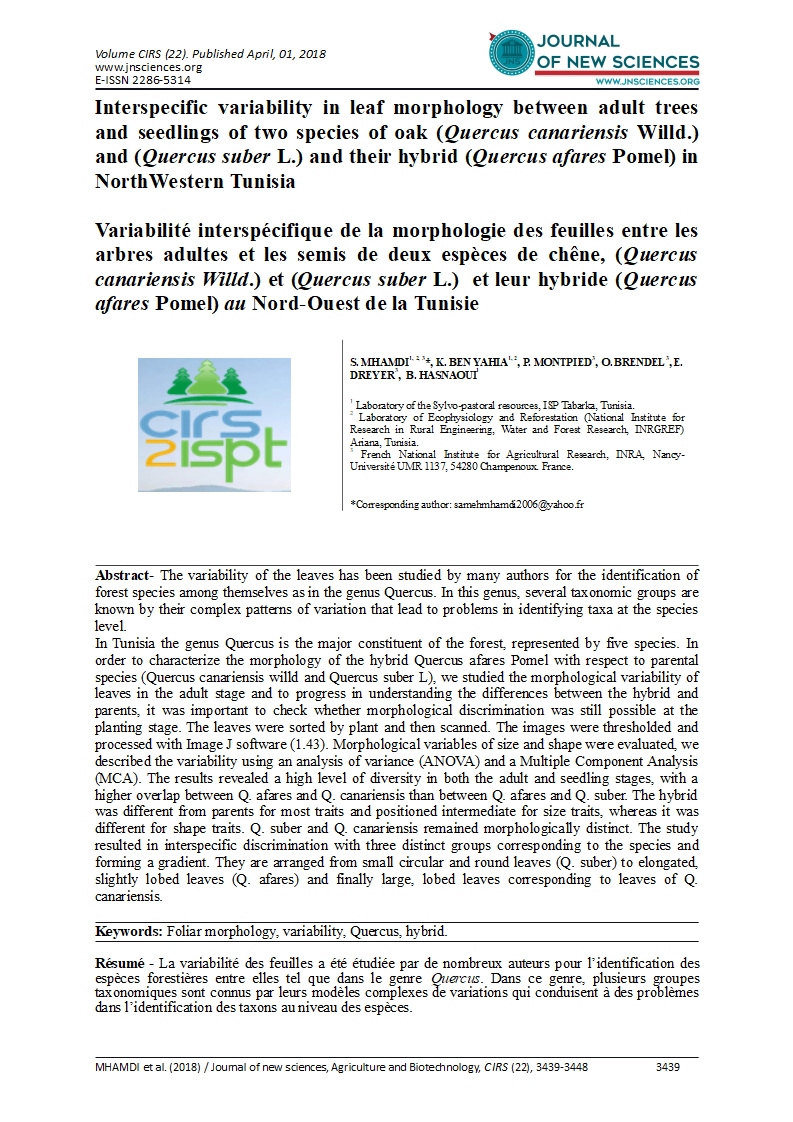

- Category: VOLUME SPÉCIAL (CONFÉRENCE CIRS 2017)
- Hits: 3299
Interspecific variability in leaf morphology between adult trees and seedlings of two species of oak (Quercus canariensis Willd.) and (Quercus suber L.) and their hybrid (Quercus afares Pomel) in NorthWestern Tunisia
Variabilité interspécifique de la morphologie des feuilles entre les arbres adultes et les semis de deux espèces de chêne, (Quercus canariensis Willd.) et (Quercus suber L.) et leur hybride (Quercus afares Pomel) au Nord-Ouest de la Tunisie
|
|
S. MHAMDI1, 2, 3*, K. BEN YAHIA1, 2, P. MONTPIED3, O. BRENDEL3, E. DREYER3, B. HASNAOUI1
1 Laboratory of the Sylvo-pastoral resources, ISP Tabarka, Tunisia. 2 Laboratory of Ecophysiology and Reforestation (National Institute for Research in Rural Engineering, Water and Forest Research, INRGREF) Ariana, Tunisia. 3 French National Institute for Agricultural Research, INRA, Nancy-Université UMR 1137, 54280 Champenoux. France.
|
Abstract- The variability of the leaves has been studied by many authors for the identification of forest species among themselves as in the genus Quercus. In this genus, several taxonomic groups are known by their complex patterns of variation that lead to problems in identifying taxa at the species level. In Tunisia the genus Quercus is the major constituent of the forest, represented by five species. In order to characterize the morphology of the hybrid Quercus afares Pomel with respect to parental species (Quercus canariensis willd and Quercus suber L), we studied the morphological variability of leaves in the adult stage and to progress in understanding the differences between the hybrid and parents, it was important to check whether morphological discrimination was still possible at the planting stage. The leaves were sorted by plant and then scanned. The images were thresholded and processed with Image J software (1.43). Morphological variables of size and shape were evaluated, we described the variability using an analysis of variance (ANOVA) and a Multiple Component Analysis (MCA). The results revealed a high level of diversity in both the adult and seedling stages, with a higher overlap between Q. afares and Q. canariensis than between Q. afares and Q. suber. The hybrid was different from parents for most traits and positioned intermediate for size traits, whereas it was different for shape traits. Q. suber and Q. canariensis remained morphologically distinct. The study resulted in interspecific discrimination with three distinct groups corresponding to the species and forming a gradient. They are arranged from small circular and round leaves (Q. suber) to elongated, slightly lobed leaves (Q. afares) and finally large, lobed leaves corresponding to leaves of Q. canariensis.
Keywords: Foliar morphology, variability, Quercus, hybrid.
Résumé - La variabilité des feuilles a été étudiée par de nombreux auteurs pour l’identification des espèces forestières entre elles tel que dans le genre Quercus. Dans ce genre, plusieurs groupes taxonomiques sont connus par leurs modèles complexes de variations qui conduisent à des problèmes dans l’identification des taxons au niveau des espèces. En Tunisie le genre Quercus est le constituant majeur de la forêt, représenté par cinq espèces. Afin de caractériser la morphologie de l’hybride Quercus afares Pomel par rapport aux espèces parentales (Quercus canariensis willd et Quercus suber L), nous avons étudié la variabilité morphologique des feuilles au stade adulte et pour progresser dans la compréhension des différences entre l’hybride et les parents, il était important de vérifier si la discrimination morphologique était encore possible au stade semis. Les feuilles ont été triées par plant puis scannées. Les images ont été seuillées et traitées avec le logiciel Image J (1.43). 11variables morphologiques de taille et de forme ont été évaluées, nous avons décrit la variabilité en utilisant une analyse de la variance (ANOVA) et une Analyse en composante Multiple (ACM). Les résultats ont révélé un niveau élevé de diversité tant au stade adulte qu’au stade semis, avec un seuil de chevauchement plus élevé entre Q. afares et Q. canariensis qu’entre Q. afares et Q. suber. L’hybride était différent des parents pour la plupart des traits et s’est positionné en intermédiaire pour les traits liés à la taille, alors qu'il était différent pour les caractères de forme. Q. suber et Q. canariensis restaient morphologiquement distincts. L’étude a abouti à une discrimination interspécifique présentant trois groupes bien séparés correspondant aux espèces, et formant un gradient. Elles sont ordonnées depuis de petites feuilles circulaires et rondes (Q. suber) jusqu’à des feuilles allongées et peu lobées (Q. afares) et enfin des feuilles grandes et lobées correspondant aux feuilles de Q. canariensis
Mots clés : Morphologie foliaire, variabilité, Quercus, hybride.
